A Father's Day Gift With Heritage
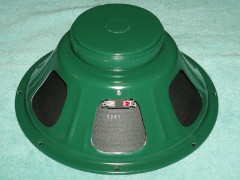
After I've played guitar for, ummm... a certain number of years, instruments and equipment with history and heritage behind them seem to become more and more important to me. One of those items was a '73 Traynor Reverb Master amp head that I recently acquired to to replace one I had owned for nearly twenty years. Acquiring that amp that got me to thinking about the speaker cabinet my father and I built many years ago and that I used with that head for its entire time with me.
Now, my dad is one of the smartest, most reasonable guys you'd ever want to meet and is a really loving man as well. Growing up around him I learned a lot about grace and patience by his interactions with me and others. He worked as an environmental engineer, creating equipment that measured the amounts of various pollutants in the atmosphere. He thought creatively about nature like we as musicians think about music. As it turns out, he was also a genius. Over the last couple of years, a series of strokes has been easing my father into the long goodbye of dementia. He still recognizes his family and friends but he can't process stimuli and react with the right actions. Buttoning a shirt and setting down his water glass in the right place are beyond his processing skills. At this point he has become an invalid and my mom has had to move him into a nursing home near our family's home. Just before he went into the nursing home my mom discovered his IQ score was 160, the same as Einstein's. We had always thought he was a genius and now we all knew it but my dad was far too humble to toot his own horn. My dad wasn't just a "head in the clouds" genius, he was a very practical one. In fact, a colleague once quipped to him, "Womack, if they ever told me NASA was going to fly me to the moon using only rubber bands, chewing gum, and paper clips, I'd want you to be the project engineer." He considered that compliment one of the finest he had ever received. Whenever there was a mechanical or electrical need in the house my dad would get a far away look in his eyes for a while and then disappear into the basement for a few hours. Eventually he would emerge with a mischievous grin and some amazing device he'd just created that would do whatever was required.
Around 1975, when my guitar gigging started to become serious, I had to work my way into equipment piece-by-piece because I didn't have the spare cash to buy it outright. When it was time for a serious electric guitar amp I could only afford the amp head proper, a Fender Bandmaster, but not a speaker system. So I saved up and bought a couple of old reconed 1960s 12" guitar speakers and asked my dad to help me build a cabinet for my amp. He scratched his head for a couple of seconds with that far-away look and said, "Ah! I know just the thing." Down in the basement we had a "Hammond Tone Cabinet," a behemoth designed to project the sound of a Hammond organ from a church's organ loft. Why did we have such a thing? I have NO IDEA. This box was two and a half feet wide, three feet deep, and just short of five feet tall and offered four twelve-inch speakers in a line. In the back there was a power amp chassis but the tubes and tube chart were long gone. It was finished in cherry veneer and sported an interesting gothic metal grille matching models from the 1930s and 1940s.
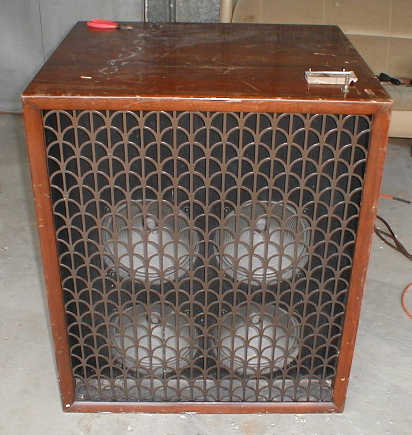
A different B-40 Tone Cab with the same grille.
My dad said, "Let's cut this thing in half and make two reasonable-sized cabinets!" And so we did, constructing new end and back panels, cleating original joints for rigidity, creating ports, and reducing the depth of the box to cut weight. We covered each of the resultant cabs in tolex and installed proper Fender handles. We loaded and wired one of the cabinets with my reconed speakers and fired it up. Voile'! Instant, velvety sound. And it sounded great! Over time I discovered that though it wasn't the most efficient cab in the world, it was very smooth sounding and brought a really cool mellow tone to the party. It was dependable and durable as well: I was never once able to overload the cabinet with my various amps. One thing, though: we never got around to fitting the box with a grille and grille cloth. Over all the years and miles I just pulled the back off the other, empty cab and stuck it in the front of the active one to protect it when I moved it.
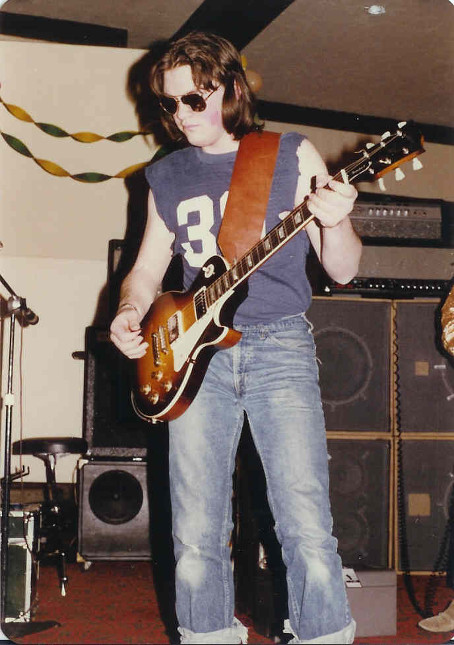
That's the cab at bottom left behind my leg.
I used that cab through many years that followed as either my main cab for a Traynor Reverb Master head or as an extension cab for my combo amps. I played more gigs than I can remember with the thing and it never once stumbled or failed me. Along the way I got married and had kids of my own who loved to listen to me play guitar through this box. But one day when they were very young, my two boys started playing with my speaker cabinet when I wasn't near. Boys will be boys. As I had when I was their age, they became fascinated with the fragile, exposed paper speaker cones. Eventually their curiousity got the best of them and they tried pushing their fingers through the cones. I'll admit that I did that at least once as a child as well. By the time I found them they had ripped up one of the cones badly enough that it rattled and fizzled and flopped loosely with every note. It was clearly beyond being repaired at home. Being loaded down with parental financial responsibilities at the time and not having any money to recone the speakers, I just put the cabinet into storage, knowing that the damage was my fault for never having built a grille for the cab.
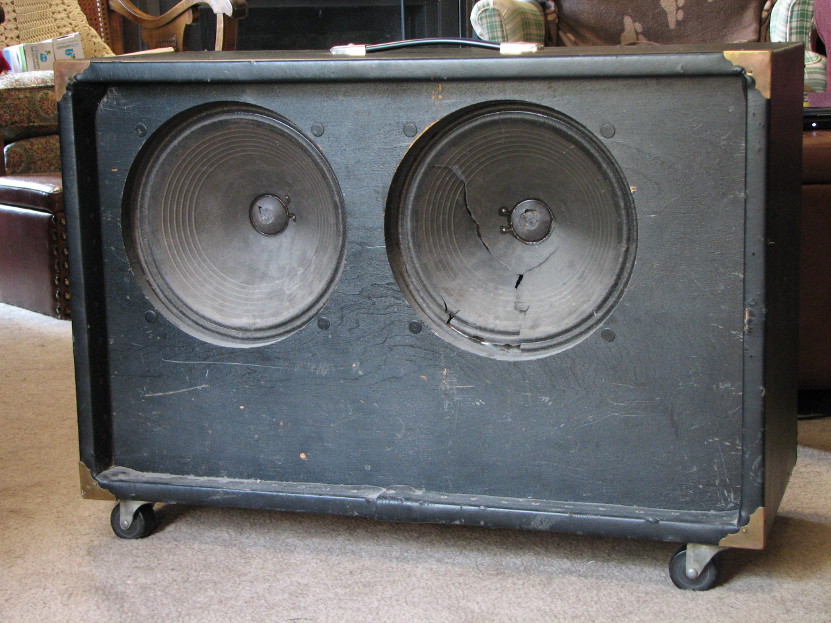
If you look closely you can still see little fingerprints on the cones.
And so, as I recently considered putting this old cabinet back into service, I went out looking for old speakers that would match the specs of mine. I had been told when I bought them that they were fifty-watt Utah speakers so the first thing I did was to launch an Internet search to see if I could find a speaker like them. I kept my eye on the market and after a few months, a reputable reconing service offered for sale a rebuilt speaker that looked exactly like I remembered my old ones. And this wasn't a half-way rebuilding job, either: The proper cone kit was used, a vented dustcap was fabricated, the cone was doped around the edges as the originals were, the basket was repainted, and the terminal blocks, gasket, voice coil and former were replaced. It was a first-class job. This Father's Day my family ordered the speaker for me.
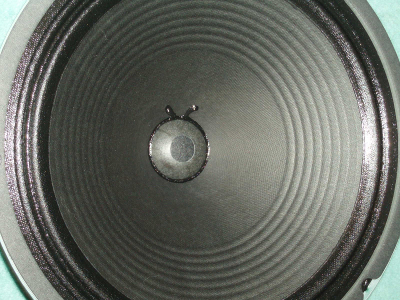
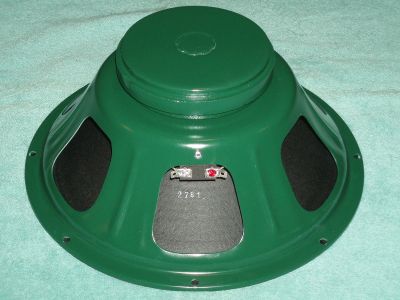
When the box arrived in the mail, I got out my tools and pulled the cab apart for the first time in thirty-five years. The moment the back came off I got a little shock: rather than a pair of Utah speakers, I had an Oxford and a Jensen! Surprise!!! They were probably pulls from a Blackface Fender Bassman, a Pro Reverb, or a Deluxe Reverb. When I bought the speakers as a teenager in 1975 I didn't know how to read speaker codes and just took the word of the salesman that they were Utahs. But the EIA codes told a different tale: The black Jensen C12NA was from the fourth week of 1967 and the gold Oxford 125L6-1 was from the thirty-seventh week of 1964. After unsoldering the harness I pulled the ruptured Oxford speaker and put it away in order to have the option to recone it as a backup one day. I mounted the new Utah speaker, tinned the leads and terminals, and resoldered the harness. Of course, then I had to test the speaker before buttoning up the cab. I tried it with a Tele and then with a Les Paul for girth. I ran the Traynor up to band levels, both clean and driven, and played the system with enough power to verify that the new speaker was sound and that my mounting and connections were good and weren't contributing any rattles or fizzes. I also found that the new recone and the old recone blended very well.

Before: Busted Oxford on the left, Jensen on the right

After: Rebuilt Utah on the left, Jensen on the right
And so, this cabinet we built nearly forty years ago from yet another cabinet, which itself was built thirty to forty years before that, has been brought back to life and is showing off its old voice again under my Traynor amp, clear, full, and tight. It now has three generations of my family's DNA in it and carries a lot of memories as well: memories of building this and many other projects with my father in our basement, memories of my boys enjoying and eventually impishly damaging it, and memories of the many happy gigs it carried me through. Now, to build a grille...
= =
=








